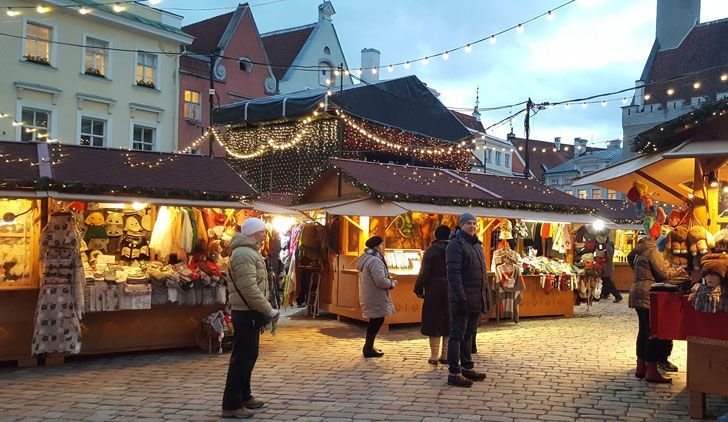In early December 2016, my wife and I visited Tallinn, Estonia’s capital, and if you’re looking for a romantic weekend, Tallinn is a good option. The Estonian capital provides visitors with the opportunity to see a historic port city dating all the way back to medieval times. You can witness remnants of ancient Europe in the city’s fortifications and rustic architecture, and immerse yourself in medieval times in the city’s unique venues.

Tallinn is the best city break location for you. Tallinn’s Old Town is one of Europe’s best surviving medieval settlements and is a UNESCO World Heritage Site. If you visit Tallinn during November and December, you may visit its Christmas Market on the Town Hall Square. On foot, you may explore Raekoja Plats, the Pikk Jalg, and Castle Square.
Tallinn is the primary gateway to Estonia for the majority of travelers. The city center of Tallinn is never more than a 15-minute drive away, regardless of whether you arrive by airline, train, coach, or ferry.
There are five things to do in Tallinn.
1. Become disoriented in Tallinn’s Old Town
As one of the greatest ways to study a city is to become disoriented in its streets, we recommend that you walk around the Old Town and attempt to become disoriented. Tallinn’s historic center is comprised of the upper town (Toompea), the lower town within the medieval walls, the 17th-century historic fortifications that encircle the entire Old Town, and a variety of primarily nineteenth-century structures, streetscapes, and views that now form a green zone around the medieval city.
Tallinn’s beginnings extend all the way back to the 13th century when crusading knights of the Teutonic Order erected a castle there. It evolved as a significant Hanseatic League center, as evidenced by the richness of the public structures – particularly the churches – and the private architecture of the merchants’ mansions, which have remarkably weathered the ravages of fire and battle over the ensuing centuries.
If you’re concerned about being disoriented, download the maps.me app to your smartphone before leaving home. After downloading the city’s map on your smartphone, you’ll be able to navigate the city without requiring an internet connection. Maps.me is an excellent substitute for Google Maps and other comparable interactive maps that rely on an Internet connection to function.
2. Indulge in regional cuisine and beer
Tallinn has several restaurants and cafés, but the medieval-themed Olde Hansa is one of the city’s most famous tourist attractions. It is centrally placed in Tallinn’s Old Town. The restaurant will whisk you away to another era. Make an attempt to sit inside the restaurant and don’t forget to use the restroom. On the menu, you’ll find the roasted bear, wild boar, and elk. You might wish to sample the honey and cinnamon beers served in ceramic cups.
If you’re looking for a contemporary restaurant, Mekk should be on your itinerary. The restaurant’s name is an acronym comprised of Moodne Eesti KöögiKunst and Moodne Eesti KöögiKunst (i.e. Modern Estonian Culinary Arts). As implied by the name, Restaurant MEKK serves contemporary Estonian cuisine. It is located in Tallinn’s Old Town on Suur-Karja street. Its menu, cuisine, and service are all outstanding. We are confident that you will be pleasantly surprised.
Another restaurant that we recommend is Kolm Sibulat. The restaurant’s name translates as ‘Three Onions,’ and here is a food lover’s paradise. They provide basic yet delectable meals and have an extensive beverage menu.
Rataskaevu 16 is one of the eateries recommended by our guide. We were fortunate enough to snag the final available table; we recommend making a reservation before visiting Tallinn’s eateries. Rataskaevu 16 – or Restaurant 16 – is a popular hangout area for both residents and visitors to Tallinn. TripAdvisor’s Certificate of Excellence 2014 further attests to the restaurant’s excellence.
3. Pay a visit to the Christmas Market
If you visit Tallinn between November and December, the Town Hall Square will be transformed into an enchanting Christmas Market. Tallinn Christmas Market runs from 18 November 2016 to 7 January 2017. It comprises a large Christmas tree in the old town square, surrounded by small illuminated buildings selling Christmas foods and folk craft goods.
4. Pay a visit to the Kumu Art Museum
Europe is one of the greatest tourist locations for discovering the world’s most magnificent museums, and Kumu Art Museum serves as the home of the Estonian Art Museum as well as the country’s largest and most stunning exhibition site. On 17 February 2006, the museum was opened. Kumu won the European Museum of the Year Award in 2008.
Kumu presents Raul Rajangu’s exhibition Soviet Midnight, which appropriates Soviet visual culture and bears evidence to the existence of Estonian Sots Art. Soviet Midnight features the exhibition’s newly discovered series Politburo (1982). This series, which is being shown publicly for the first time at this exhibition, demonstrates how the artist transformed placards with portraits of Soviet Politburo members into works of art. At the time, placards with portraits of Soviet Politburo members were widely available in book stores but were primarily hung in administrative offices. The show will run through 2 April 2017 in the Kumu Art Museum’s project room on the fourth floor. The exhibition’s graphics are available in the Art Museum of Estonia’s digital collection.
Currently, Kumu Art Museum is home to an exhibition of the work of Paul Delvaux, one of the twentieth century’s most eminent Surrealists. The show is accompanied by a series of activities named “Delvaux & Draw,” which includes four sessions of naked model sketching in the Kumu exhibition hall alongside Paul Delvaux’s paintings. The show ‘Paul Delvaux. A Waking Dreamer’ will be on view at the Kumu Art Museum’s Great Hall until March 12, 2017.
5. Visit the Estonian Open Air Museum to learn about Estonian living.
Estonian Open Air Museum, located on the city’s western outskirts, is a wooded park that recreates traditional Estonian village life. The museum has 74 structures dating from the last two centuries, including farms, mills, net sheds, a village school, a chapel, and a firehouse.
You’ll get a sense of how people lived in the past. Museum staff dressed in period costumes will demonstrate ancient crafts and take you on a trip through time.
The museum is located on the coast of Kopli Bay in the territory of the Rocca al Mare summer house, which was founded in the nineteenth century. The museum is currently under construction and will open to the public in August 1964.
While in the museum, lunch at the historic Kolu Krts pub or at more modern establishments like Lucca and Rucola, as well as Meister Lyon, which is famed for its pastries. Additionally, there is the sprawling Rocca al Mare shopping mall, which features a diverse selection of cuisines and hundreds of top brand names, both domestic and international.
We also visited the Tallinn Handicraft Fair on the Song Festival Grounds, saw The Nutcracker Ballet at the Opera House as an amazing Christmas treat, and listened to a special concert by Kultuurikatla Black Box at JazzKarr. The special performance ‘6 strings 4 voices’ introduces audiences to passionate original compositions composed for a rather uncommon musical combination – guitars and choir.
Where are you going to stay?
We stayed at the Park Inn by Radisson Tallinn Central. Our accommodation was spacious and the breakfast was excellent. The hotel is ideally positioned in Tallinn’s central business district, just a 5- to 10-minute walk from the Old Town. You can reach the hotel via taxi in less than 15 minutes from the airport.

